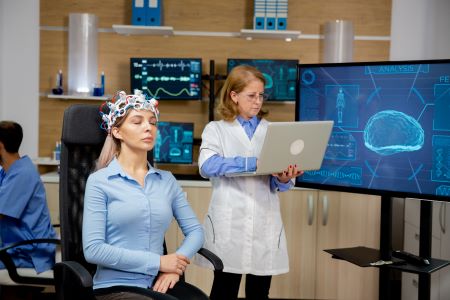
Canada will need a carefully balanced approach in tackling ethical, legal and societal concerns about rapid advances in neurotechnology, say academics, entrepreneurs, and users of emerging innovations in neurotechnology.
Such concerns must be addressed in a way that protects Canadians, yet does not stifle innovation and ensures equitable access to neurotech for people who need it, they told a Health Canada-sponsored webinar presented by the Canadian Science Policy Centre.
“Advances in neurotechnology are really redefining the possibilities of improving neurological and neuropsychiatric health and mental wellbeing,” said Dr. Judy Illes, PhD, professor of neurology at the University of British Columbia. She is also the chair of the International Brain Initiative, an international collaboration between Canada, U.S., Australia, the EU, South Korea, China, and Japan to advance neuroscience.
The rapid pace of neurotech development also is raising concerns, such as the privacy of brain data, manipulation of personal information, people’s autonomy and self-agency, and non-medical and dual uses of neurotech, said Illes, who moderated the “Strategies for Responsible Neurotechnology Innovation” webinar last month.
This presents challenges for federal and provincial health care systems and for existing laws and regulations that govern responsible innovation, she said.
There’s urgency to address those challenges because Canada, as an OECD member state, has been asked by the OECD Council to implement recommendations including nine principles for responsible neurotechnology. Canada helped develop the document and is a signatory to it, said Andrew Atkinson, manager of emerging science policy at Health Canada.
The OECD Council’s nine principles encompass:
- promoting responsible innovation
- prioritizing safety assessment
- promoting inclusivity in neurotech development and use
- fostering scientific collaboration across a range of stakeholders and many disciplines
- encouraging societal cooperation and a diversity of opinions
- addressing the capacity of oversight and advisory bodies
- safeguarding personal brain data and other information
- promoting stewardship and trust across the public and private sectors
- addressing potential misuse or unintended use of neurotechnologies.
“The question facing us is: What is the model of implementation that is best fit for Canada?” Atkinson said.
Dr. Graeme Moffat, PhD, neurotech entrepreneur and a senior fellow at the Munk School of Global Affairs & Public Policy at the University of Toronto, said a Canadian-made neurotechnology called Muse is probably the most successful consumer-oriented nanotech device in the world,
Muse, made by Toronto-based Interaxon, is a headband that uses advanced electroencephalogram technology (which measures electrical activity in the brain) to help people meditate and get better sleep. The device tracks brain activity, heart rate, posture, breathing patterns, body movements, and sleep stages.
“We’re seeing more of this type of integration of neurotechnology with standard wearable technology,” Moffat said.
Ian Burkhart, founder of the BCI Pioneers Coalition, a neurotech advocacy group, suffered a spinal cord injury 13 years ago which left him as a quadriplegic with minimal use of his arms and no function of his hands.
Through a clinical trial research project, Burkhart received an implanted BCI (brain-computer interface) device in his motor cortex, the part of the brain that controls body movements. The device essentially reads his thought intention about moving his arm and then translates that brain activity to a computer which triggers stimulation on the surface of his skin.
“With that technology, I was able to restore function in my own arm to do things like play a guitar, play a video game, pick up a bottle and take a drink out of it, pour a bottle, swipe a credit card through a credit card reader, and do more dexterous movements with my hands,” he said.
BCI implanted devices have enabled people with disabilities to: control a robotic arm or a mouse cursor; think of handwriting and have it vocalized through a synthesizer; or — in a device coupling BCI technology with an AI-enabled “thought decoder” — think of walking and learn how to walk normally again.
In implementing the OECD Council’s recommendations, Canada needs to ensure medical neurotech devices are safe, applicable to the widest community possible, and work well for the intended target audience, Burkhart said.
It is also crucial to involve the intended end-users of neurotechnologies in their development, testing, and deployment, as well as ensuring affordability and equitable access for those who need them, he added.
Brain data could be used for harmful purposes
The brain data collected by neurotechnologies could be used for secondary purposes that might not be intended or desired and may harm or disadvantage people, said Jennifer Chandler, professor of law at the Centre for Health Law, Policy and Ethics at the University of Ottawa. She specializes in neuroscience law.
Along with brain-computer interface devices, brain stimulation via putting an electrode into the brain for neuro-modulation is used to treat Parkinson’s disease, obsessive-compulsive disorder, epilepsy, and other conditions, Chandler noted.
In addition, telemedicine technology is increasingly being used to remotely adjust deep-brain stimulation in patients who have had the procedure, she said.
“If one thinks about closed loop in the collection of brain data, together with moving into virtual care models, we’re going to have brain data streaming around over the Internet,” Chandler said.
While this approach is convenient and improves care, she cautioned that “The values related to freedom of thought, self-determination and privacy are at stake if brain data can be accessed, interpreted and then used to draw conclusions about people.”
Chandler pointed to recent case in Ohio of a man being criminally prosecuted for arson. He had an implanted pacemaker and the data from his device was subpoenaed to essentially prove he was unlikely to be telling the truth about his actions at the time his house burned down.
In another case, a man with implanted deep brain stimulation to treat epilepsy was accused of assaulting someone. He retrieved his device’s brain data to show that in fact he had been having a seizure at the time of the alleged assault.
Chandler said that Canada, in implementing the OECD Council’s recommendations, has a range of approaches it could use to influence the development and use of neurotech, including:
- using market pressure or public relations to influence neurotech developers
- adopting rules, norms, and best practices, including for adjudicating disputes and enforcement, within the industry
- utilizing “soft law,” quasi-legal instruments such as recommendations and guidelines. Although soft law does not have explicit binding force, Chandler noted it often becomes the legal standard over time, as courts refer to the industry consensus in settling disputes.
- employing “hard law” legislation, which has the advantages of being uniform, predictable, and certain.
Although hard law has its advantages, Chandler said, “one doesn’t want to create a constraining regulatory regime that distorts and impedes innovation.”
The federal government’s Bill C-27, now before Parliament, has proposed major changes to the Personal Information and Data Protection Tribunal Act. The proposed legislation includes the Artificial Intelligence and Data Act that “will put a range of quite onerous obligations on those who operate ‘high impact’ systems,” Chandler noted, while defining those systems is to be determined by the regulations.
In the absence of regulatory certainty, he added, investors could balk at backing a company. Canada, in regulating medical devices, relies more on soft law than hard law approaches compared with countries like the U.S. or EU.
“There’s room for more regulation, for more hard law that would actually help innovation in Canada, and that would bring technologies to market more quickly,” he said.
Canada’s neurotech industry faces stiff competition
Along with addressing the ethical, legal and societal concerns of neurotech, Canada’s neurotech industry faces increasingly stiff international competition.
Not many Canadian neuro-modulation tech companies have gotten to scale outside of the medical space, Moffat said.
While Canada had an early lead in neurotech, he said, thanks mainly to the country’s strengths in academic neuroscience research, “Canada has not seen the industry growth that we’re now seeing in the U.S. and Asia. Most of the growth now in the neurotechnology industrial sector is occurring outside of Canada."
That presents not only an economic risk to Canada, but the risk of not capitalizing on our strong neuroscience research. “As the industry develops abroad and not here at home, we face this additional risk that whatever regulations or recommendations or guidelines that we develop will have an arguably smaller influence if we don’t succeed in nurturing homegrown innovation in neurotechnology here in Canada and in scaling it to market internationally.”
Queen’s University, in partnership with the non-profit organization NeuroTechX and the Ontario government, has launched a new online micro-credential program in neurotech. Queen’s University also is developing a neurology risk assessment tool template based on the OECD Council’s principles.
In implementing the OECD Council’s recommendations, Canada needs to set goals, through consultation with all stakeholders, on what outcomes the country wants to achieve with neurotech, Moffat argued.
According to Atkinson, Health Canada’s next move will be to reach out to stakeholders to see who wants to be at the table with regulators, industry, and government, including Innovation, Science and Economic Development Canada. The intent is to create an ad-hoc task group to look at ways to implement the OECD Council’s recommendations and nine principles in a way that will be best for Canada.
R$
Events For Leaders in
Science, Tech, Innovation, and Policy
Discuss and learn from those in the know at our virtual and in-person events.
See Upcoming Events
You have 1 free article remaining.
Don't miss out - start your free trial today.
Start your FREE trial Already a member? Log in
By using this website, you agree to our use of cookies. We use cookies to provide you with a great experience and to help our website run effectively in accordance with our Privacy Policy and Terms of Service.





